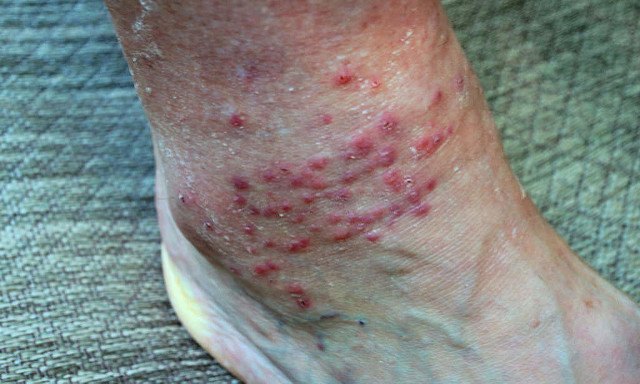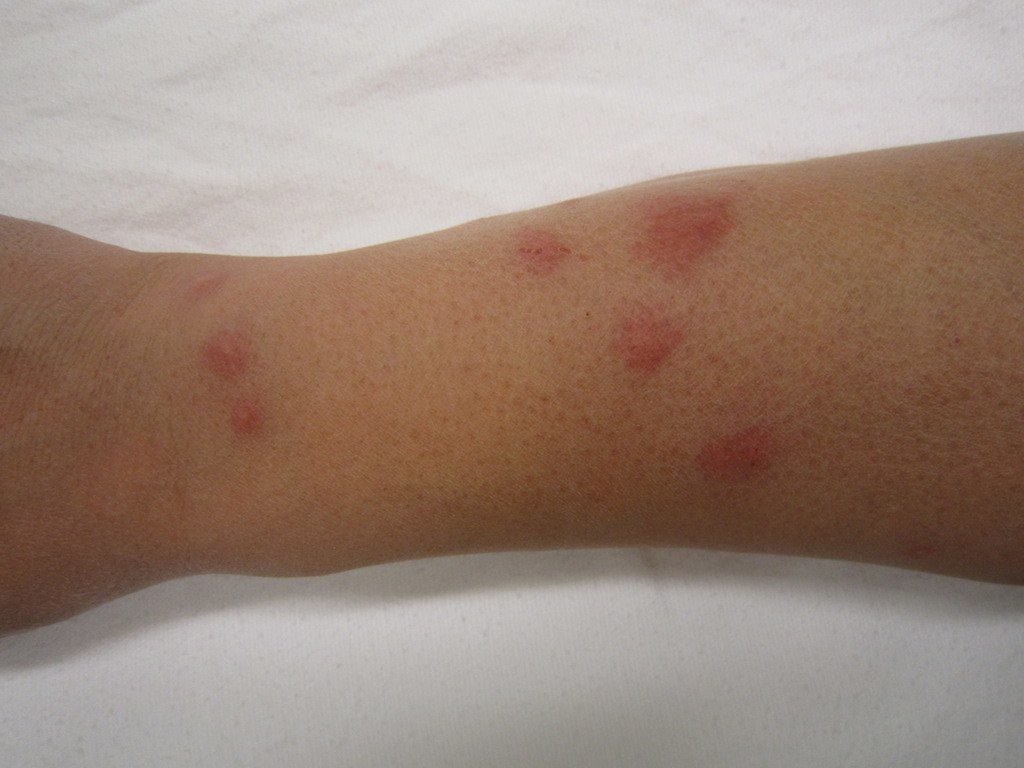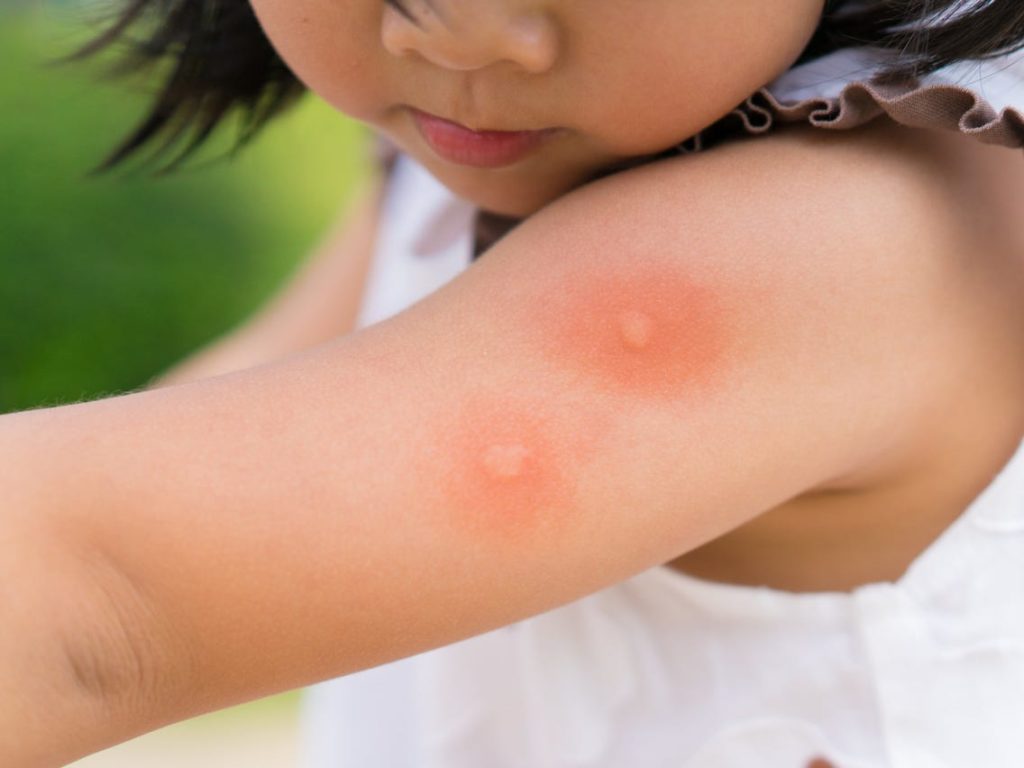You’ve just returned from an outside activity, whether it was gardening or playing with your children. While your body will undoubtedly appreciate the extra dosage of fresh air and vitamin D, spending more time outside can also bring with it some additional annoyances, such as mosquito bites.
If you suddenly detect an itchy rash, you may be wondering what’s going on and whether you should seek treatment at a nearby emergency department to relieve the itch.
Chigger Bites are the primary source of this irritation.
Chiggers are one of the most common biting insects during the summer. While these bites are annoying, they are fairly easy to treat. You can follow some home remedies to prevent them.
In this article we’ll try to cover everything related to chigger bites like what chiggers are, how they bite, how chigger bites look like, the symptoms they cause, how to treat and prevent chigger bites, etc.
What Are Chiggers?

Chiggers, sometimes known as “red bugs,” are parasitic larvae of mites, according to the NYC Department of Health and Mental Hygiene (DOH). A magnifying glass is required to observe chiggers, which are roughly 1/150″ long. The six-legged, hairy larvae are generally red or orange in appearance, but after feeding on their host, they turn yellowish.
Humans are not the ideal host for chiggers (technically referred to as Trombicula alfreddugesi). They typically prey on small mammals, birds, reptiles, and amphibians, but people can become unintentional hosts if they come into touch with chiggers in regions with weeds and tall grass, which is common in late spring and summer.
A particular species of Chigger lives in the Southeastern United States and is best known as the hardest-biting Chigger in the world.
The Chigger Life Cycle

The life stages of chiggers:
Chiggers begin as eggs laid by adult Chiggers on leaves and plants. They then hatch (becoming larva) and wait for a host to feed on. When a host gets near their location, they jump onto the host. Chigger larvae often stay together in groups and often also move to a host in groups as well.
Eggs -> Larva -> Nymph -> Adult
The preferred host is humans, but Chiggers aren’t real picky and will seek out all animals with skin. Yes, skin more on that below under Chigger Bites.
The chigger larva stage is problematic for people, as that is the only time Chiggers seek out skin to feed on. After a week or so of feeding, they drop off the host and develop into their nymph stage.
Nymphs then develop into adults, where they primarily live in soil and feed on small arthropods and their eggs. They are also known to feed on plant material as well.
Where do Chiggers live?
Unfortunately, Chiggers are found all around the world in moderate to hot climates. They are highly prevalent in the southeastern United States, where one of the most painful species is prevalent.
Chiggers can almost be found anywhere but frequently in grassy and woodland areas, including yards, fields, and golf courses. They generally prefer damp and moist conditions, but that is not a requirement and can be found in dry areas.
What Are Chigger Bites?

Chigger bites are caused by tiny mite larvae. Chiggers, crimson bugs, and harvest mites are some of the names given to these larvae. Chiggers live in low grasses and shrubs all year in tropical, humid regions, or in nontropical areas during the summer and fall months. They cling to and bite exposed skin on people who spend time in their environment.
Bite clusters are common near areas of tight clothing, such as the ankles or waistline. When mites connect to the skin, they inject saliva that tears down skin cells. The immune system of the infected person subsequently reacts to the chemical compounds in the mites’ saliva, causing many of the symptoms associated with chigger bites. Chiggers may contain the bacteria Orientia tsutsugamushi in places near Southeast Asia and Australia, which can cause scrub typhus in afflicted humans.
How To Identify Chigger Bites?

One of the most asked questions is, “What do chigger bites look like on human skin?”
At first, a chigger bite may only be apparent as small red dots on the skin caused by the chiggers themselves. The bites may emerge as groups of tiny, itchy, red pimples once the individual’s immune system reacts. If the individual has previously been exposed, this reaction may begin within hours. The redness and swelling can last for several weeks following the bite.
Chiggers bite most frequently in areas of thin skin, such as creases and folds. As a result, chigger bites are frequently seen in the crotch and groin areas, the armpits, and the creases behind the knees. Chigger bites are also frequent on the ankles. Other regions where chiggers bite frequently are those where clothing constriction (such as belts) creates impediments to their travel.
A common misconception about chiggers is that they burrow into the skin and stay there, however, this is not true. When a chigger bites, its feeding structures and mouthparts are inserted into the skin. They inject enzymes into the host skin, causing the host tissue to deteriorate. The bite area then hardens and a feeding tube called a cyclostome develops. If this structure is not disturbed, chiggers can feed on the skin for a few days.
How Long Do Chigger Bites Last?
The chigger bites itch immediately once the chigger attaches to the skin. The itching subsides after a few days, and the red bumps disappear within 1–2 weeks.
Itching typically lasts many days and can keep you awake at night. Your skin may also turn red and develop lumps, blisters, or a hive-like rash, which may take a week or two to cure.
If you acquire a chigger bite on your penis as a man, you may develop a disease known as “summer penile syndrome.” It causes swelling, itching, and urinary incontinence. This can last anywhere from a few days to a few weeks.
Signs And Symptoms Of Chigger Bites
Itching is caused by chigger bite discomfort. The bites are well-known for eliciting symptoms like:
- Scratching and burning sensations around the ankles, groin, behind the knees, armpits, and waist (near the beltline)
- Severe itching occurs during the first 24 to 48 hours of a bite and lasts for many days.
- Red areas that can be elevated or flat, look like blisters or red bumps, and can last up to two weeks.
Signs Of Infection
Chigger bites, like any bug bites, can get infected. This danger is increased by scratching. Any bite, no matter how minor, should be monitored.
After 24 hours, pus and crust around a bite can suggest impetigo, a highly contagious bacterial skin condition. Meanwhile, redness, soreness, swelling, and warmth might be symptoms of cellulitis, a potentially fatal bacterial skin infection.
Do Chigger Bites Spread?
Chigger bites cannot spread since they only occur where the mites have bitten a person. As a result, chigger bites cannot be passed on to another person. Attached chiggers generally slip off the skin quickly, whether the individual scratches them off, tight clothing rubs them off, or they fall off on their own once they have eaten enough. The chigger normally dies shortly after emerging from the skin.
How To Treat Chigger Bites?

To avoid future bites, your first aim should be to get rid of the chiggers. Then you can concentrate on relieving your discomfort.
- Give Chiggers the Brush-Off – When you first notice a bite, the chiggers are likely still on your skin. They can be removed by just brushing them away.
- Take a warm shower or bath if you haven’t already started itching. Then, give your skin a good massage. If you’ve started itching, be aware that showering or bathing will most likely not provide any relief at this stage.
- Soothe Chigger Bites – Aside from applying calamine lotion or cortisone cream, you can relieve the itching caused by chigger bites in the following ways:
- Applying petroleum jelly, baby oil, or cold cream
- Taking an oatmeal bath with colloidal oatmeal (crushed oat grain).
- Applying a cold compress, an ice pack, or a bag of frozen veggies to the affected area
- Chigarid, a topical therapy available in many pharmacies that mix camphor, menthol, and phenol, is used.
- Taking an antihistamine
It should be noted that some calamine lotions and cortisone creams contain an antihistamine. While they may provide more comfort than versions without one, you should never use an oral and a topical antihistamine at the same time. Most of the time, you’ll just have to bear it. The itching could last for up to two weeks.
If you still feel the need to scratch your skin, try tapping it instead of scratching it.
Home Remedies For Chigger Bites

Chigger bites can be treated at home in a variety of methods. You should concentrate on getting the chiggers off your skin, alleviating itching and suffering, and avoiding infection. Always follow the advice on any chigger bite treatment items you use.
There’s no need to “suffocate” chiggers with nail paint or petroleum jelly, as you would with fleas.
- Bath or Shower – Bathing or washing in hot water after being bitten by chiggers may help eliminate any leftover bugs and soothe your skin. Apply soap to your bath or shower and use a washcloth to rub against your skin to guarantee they come off. If the location itches, chiggers are most likely no longer present. If the chigger bites itch, a cool shower or bath may help relieve your symptoms.
- Colloidal oatmeal – Colloidal oatmeal protects the skin while also reducing irritation and inflammation. For generations, it has been used as a home remedy. It may be beneficial in treating chigger bites, particularly when used in conjunction with bath products or moisturizers after bathing or showering. Colloidal oatmeal items can be found at your local drugstore or supermarket shop. Follow the product packaging’s instructions.
- Calamine Lotion – Calamine lotion is an over-the-counter medication that can relieve itching and soothe your skin. It can also be used to dry out bug bites that have begun to leak slime. You can use it several times per day.
- Essential Oils – The Food and Drug Administration does not regulate essential oils as supplementary or alternative medicine. Essential oils should be used with caution. Some essential oils for insect bites that may relieve inflammation or irritation are as follows:
- Tea tree oil
- Lavender
- Camphor
- Rosemary
- Basil
Before using essential oils on your skin, dilute them with a carrier oil or moisturizer. Do not consume them or place them near your eyes.
Chigger bites may also be helped by essential oils. One study indicated that clove, tea tree, cassumunar ginger, and eucalyptus globulus all repelled chiggers 100 per cent of the time.
- Ice Pack or Cold Compress – Chigger bites that itch should be treated with an ice pack or a cold compress. To avoid excessively cold temperatures directly touching your skin, place a towel or a light cloth between an ice pack and your skin.
- Fingernail Hygiene – Keep your fingernails short so that you don’t scratch the damaged skin. Infections can result from scratching chigger bites with sharp or long nails.
- Over-the-counter medications – You can treat chigger bites with a variety of over-the-counter remedies, including:
- Antihistamines used orally relieve itching and irritation. One form of antihistamine is diphenhydramine (Benadryl).
- Pain and discomfort can be relieved with oral drugs such as acetaminophen or ibuprofen. Ibuprofen can also be used to treat inflammation.
- Topical lotions with substances that relieve itching, inflammation, and irritation can also be beneficial. Look for items that contain camphor, menthol, or pramoxine. Hydrocortisone is a topical steroid medication that may ease symptoms.
- Topical antiseptics disinfect the bite site and lower the risk of infection.
You can read more about treatment in our Chigger Bite Treatment Guide.
How To Kill Chiggers?
The trick to killing a Chigger infestation is determining where they are in your home. Chigger adults are not difficult to see, as they are bright red and often live in the soil.
Chigger nests are often found in pine straw, mulch, grass, and tall grass in your yard. Generally, anywhere they can hide and have protection.
Chiggers aren’t very hardy, though and tend to avoid direct sun and short grass. So you’ll want to focus on shaded areas with ground cover (like mulch or pine straw) and taller grass or plants.
If you have a smaller-sized lawn, it is best to treat your entire yard.
To Kill Chiggers in your hard, do the following:
- Purchase a liquid insecticide and yard sprayer. We recommend Permethrin, but numerous other products work as well, including Liquid Sevin.
- Mix the insecticide according to the directions in the sprayer.
- Wear long pants, a long-sleeve shirt, and boots. Tuck your pants legs into your boots. You can also purchase and wear a protective suit (Warn your neighbors!)
- Per the instructions, spray your yard with the liquid insecticide mixture. Repeat as recommended in the product instructions.
How To Prevent Chigger Bites
It is not difficult to avoid chigger bites, but you must transform yourself into an uninviting host in order for them to leave you alone:
- Put on a long-sleeved shirt and long slacks that are tucked into your boots or shoes.
- Wear the heaviest apparel you can tolerate in light of the weather.
- From your feet up, apply a bug spray containing DEET (diethyl toluamide) or picaridin to your clothing. Every two to three hours, reapply the spray.
When you get home:
- Examine your skin for bites.
- If chiggers have attached themselves to your skin, wash it off.
- Wash your clothes (and any additional clothing, blankets, or towels that may have come into contact with the ground) in hot, soapy water.
You can read more about chigger bites identification and prevention in detail here.
Chigger Bites Vs Bed Bug Bites

Bed bug and chigger bites are both present on your skin as raised, red, inflammatory patches.
Bed bug bites are most common near exposed skin and might appear in lines or in random clusters. Chigger bites are concentrated in areas near tight-fitting garments.
Read more about the comparison between chigger bites and bed bug bites in detail.
Chigger Bites Vs Flea Bites

Flea bites on people tend to be localized around the ankles and feet since they can only jump up seven inches vertically.
The bite of a flea is often in the form of a straight-line cluster of three to four bites surrounded by crimson halos. The most obvious aspect when evaluating if you come into contact with a flea is the crimson halo ring.
Chiggers, unlike fleas, like to attack locations where clothing fits tightly or at body creases, such as underwear bands, sock elastic bands, elbows, armpits, knees, and private parts. The warmer, tighter, and sweatier a place is, the more enticing it is to them.
Chigger bites are also close together and widespread, resulting in bites that seem like pimples, welts, blisters, hives, or a random cluster of bites all over the body. A chigger bite is easily distinguished from a flea bite by its size, as chigger bites are typically much smaller and resemble a little pimple.
Here’s a more detailed article on chigger bites vs flea bites.
Mosquito Bites Vs Chigger bites

While both chigger and mosquito bites produce itching, chigger bites cause extreme itching that can last a week or more, whereas mosquito bites cause itching that lasts three or four days.
Chiggers often bite below the waistline. The bites can be seen in areas such as the armpits and bra line. Chiggers want a liquified skin cell meal and can readily find one by crawling from the ground to your bare feet (or shoes) and latching to the skin.
Bites typically manifest as tiny, reddish lumps that resemble pimples, with acute itching that is generally worse at night.
On the other hand, mosquitoes have easy access to your face, ears, and scalp. Mosquitoes are looking for blood, but only female mosquitoes bite.
Mosquito bites do not have a distinct style. Pink to red raised itching lumps that might be individual or clustered, isolated or widespread.
Chigger Bites On Dogs

Chigger bites can occur in dogs. Because of their fur, they are more protected, yet chiggers can still attack their heads, neck, or ears. Chigger bites may be more common in dogs with short hair.
Because chiggers are so minute, you may not see them even if you inspect your dog after being outside. However, you may notice your dog become extremely itchy in one area of its body for several hours to a day after being bitten by chiggers.
Chigger bites are sometimes misdiagnosed as skin irritation (dermatitis), fleas, scabies, or even an allergic reaction to something.
That is why it is critical to understand how to diagnose chigger bites on dogs.
For that read our detailed article about chiggers on dogs.
Closing Thoughts
There are various home remedies for chigger bite pain. Before you begin treating the discomfort, itching, and swelling, make sure you remove the bugs from your skin.
You can try over-the-counter drugs, washing, and possibly essential oils to relieve discomfort. Call your doctor if your symptoms persist or worsen.
If you found this detailed article on chigger bites helpful, then share it with your peers who are unaware of the home remedies for these bites.
Did you ever get Chigger Bites? Comment down below to let us know what remedy worked best for you!
Frequently Answered Questions
Q1. Can there be Allergic reactions to chigger bites?
Yes, in some cases chigger bites may cause some allergies. These include difficulty breathing, chest or throat constriction, and feeling faint or dizzy. These bites may also trigger alpha-gal, an uncommon allergic reaction to red meat.
Q2. How To Stop Chigger Bites From Itching?
Wash your clothes and any blankets or towels that have come into contact with the ground in hot water to destroy any bugs that have remained. Then, apply an over-the-counter anti-itch cream or ointment, such as menthol, calamine lotion, or hydrocortisone, to the bites.
Q3. Can You Get Chigger Bites On Feet?
Chigger bites can occur anywhere on your body, although they most commonly appear in clusters around the waist or lower legs. You may not notice anything amiss at first, but after a few hours, you will begin to itch.
Q4. Can You Get Chigger Bites On Ankles?
Chigger bites are irritating red spots that resemble pimples, blisters, or small hives. They are most commonly found around the waist, ankles, or in warm skin creases. They become larger and itchier over time, and they frequently appear in bunches.
Q5. How To Get Rid Of Chigger Bite Scars?
While existing scars cannot be removed with a magic wand, you can hasten their fading by using specific topical creams, lotions, and gels to them on a daily basis. Aloe vera, cocoa butter, Vitamin E, honey, and other moisturizing components are commonly used in scar treatments.
Q6. What To Put On Chigger Bites?
To assist remove any chiggers that are still stuck to the skin, scrub chigger bites well with soap and water. A cool towel placed over the bites might be helpful. Itching can be relieved with calamine lotion or anti-itch lotions.
Q7. Is Nail Polish For Chigger Bites Effective?
It’s a myth that nail polish can be used on chigger bites to reduce the itching and smother the bugs. The damage is done once the chigger bite is evident.
People Also Search For:

